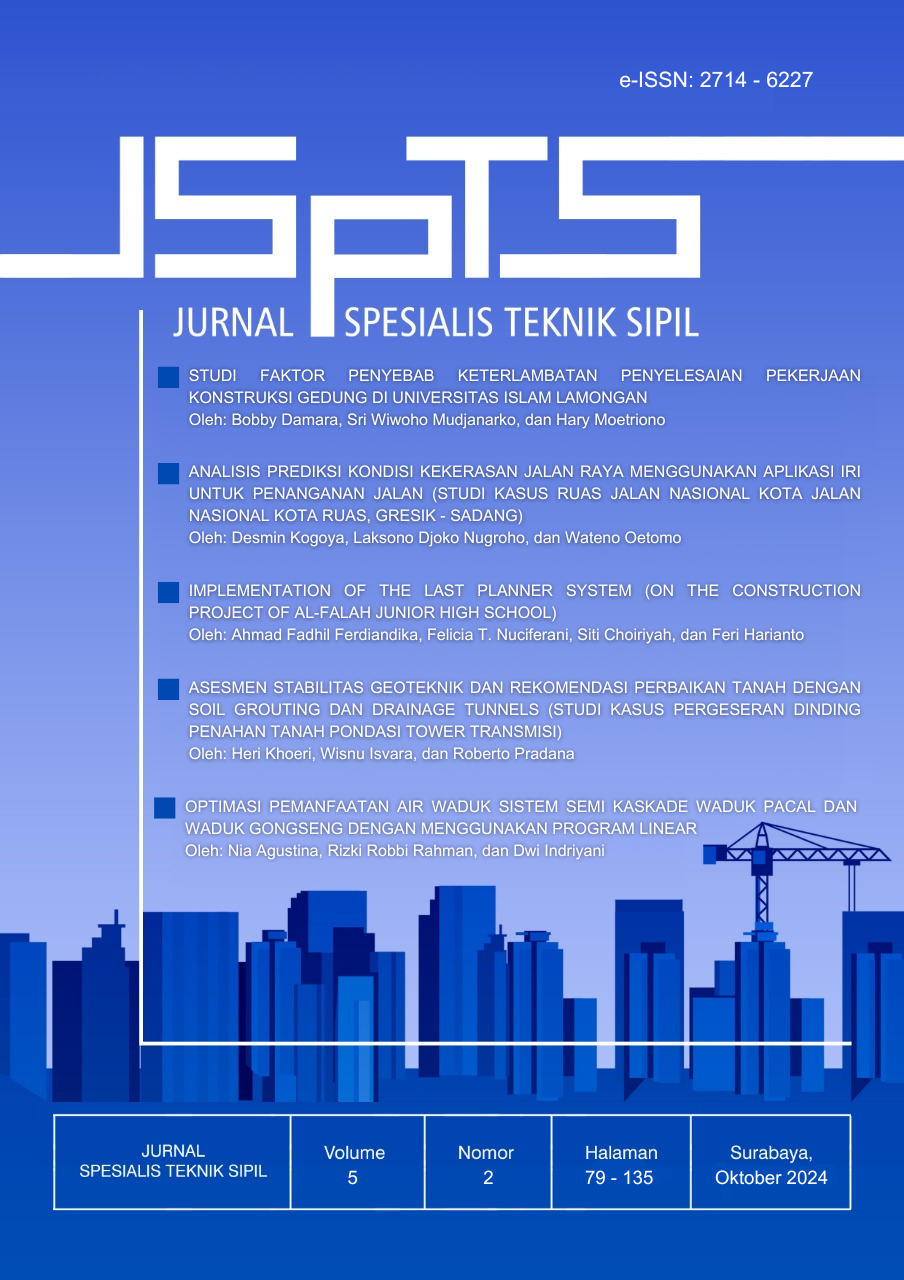Geotechnical Stability Assessment and Soil Improvement Recommendations with Soil Grouting and Drainage Tunnels (Case Study: Displacement of Transmission Tower Foundation Soil Retaining Wall)
Abstract
The detection of a retaining wall displacement in early 2023 at one of the DD6+12 transmission tower sites raised concerns about the tower's stability, potentially leading to structural failure. A comprehensive assessment was conducted on the tower's verticality, retaining wall displacement, subsurface conditions, and soil properties around the tower area. The assessment results revealed a linear inclination of the transmission tower from the base to the top, with a deflection at the top of approximately ±20 cm to the south and ±7 cm to the west. With this condition, some structural elements reached a stress-to-permitted stress ratio of 0.91. Although still within allowable limits, without soil stabilization, it is at risk of structural failure. GPR scan results showed differences in foundation dimensions compared to the as-built drawings and identified cavities filled with water beneath the ground surface due to poor drainage, resulting in a safety factor of 1.088, whereas the required safety factor is 1.5. This condition caused the retaining wall displacement. Recommendations including constructing drainage tunnels upstream, soil grouting, installing wheep holes in the retaining walls, and adding secant piles would increase the safety factor to 1.988.
Downloads
References
ASTM. (2017). ASTM D4318-17e1, Standard Test Methods for Liquid Limit, Plastic Limit, and Plasticity Index of Soils.
ASTM. (2018). D2573M-18, Standard Test Method for Field Vane Shear Test in Saturated Fine-Grained Soils.
ASTM. (2020). ASTM D4767-20, Standard Test Method for Consolidated Undrained Triaxial Compression Test for Cohesive Soils.
ASTM. (2023). ASTM D2850-23, Standard Test Method for Unconsolidated-Undrained Triaxial Compression Test on Cohesive Soils.
Badaruddin, B., & Khoeri, H. (2017). Analisis Numerik Pada Perpindahan Abutment Jembatan Akibat Konstruksi Tanggul: Studi Kasus Pada Jembatan Yang Dimiliki Oleh Perkebunan Kelapa Sawit. Konstruksia, 8(2).
Bhuiyan, M. R., Masum, S. R., Parvej, M. T., & Sanuwar, S. M. (2024). An Overview of Soil Improvement through Ground Grouting. Journal of Geoscience and Environment Protection, 12(01), 51–63. https://doi.org/10.4236/gep.2024.121004
Bilfinger, W., F.S. de Mello, L. G., & Dzialoszynski, B. S. (2020). Stabilization of major soil masses using drainage tunnels. Soils and Rocks, 43(3), 397–418. https://doi.org/10.28927/SR.433397
BSN. (1998). SNI 03-4804-1998, Metode pengujian berat isi dan rongga udara dalam agregat (439/BSN-I/HK/08/1998).
BSN. (2002). SNI 19-6724-2002, Jaring kontrol horizontal.
BSN. (2008). SNI 3423: 2008, Cara uji analisis ukuran butir tanah.
BSN. (2017). SNI 8640:2017; Persyaratan perancangan geoteknik. www.bsn.go.id
BSN. (2018). SNI 2813: 2018, Cara Uji Kuat Geser Langsung Tanah Terkonsolidasi dan Terdrainase.
BSN. (2019). SNI 4153:2019, Metode uji penetrasi standar (SPT) dan pengambilan contoh tanah dengan tabung belah (ASTM D 1586-11, IDT) (458/KEP/BSN/10/2019).
BSN. (2020). SNI 1729: 2020; Spesifikasi untuk bangunan gedung baja struktural.
da Rocha Gomes, S., Ferrara, L., Sánchez, L., & Moreno, M. S. (2023). A comprehensive review of cementitious grouts: Composition, properties, requirements and advanced performance. Construction and Building Materials, 375, 130991. https://doi.org/10.1016/j.conbuildmat.2023.130991
Halim, J. B., Chaidir, D., & Makarim, A. (2020). Analisis Dinding Penahan Tanah di Daerah Aliran Sungai Menggunakan Program MIDAS GTS NX. In JMTS: Jurnal Mitra Teknik Sipil (Vol. 3, Issue 4). https://doi.org/http://dx.doi.org/10.24912/jmts.v3i4.8374
Imran, F., Afriani, L., & Zakaria, A. (2020). Analisa Kestabilan Lereng dan Metode Penanganannya Pada Tanah Lempung Berpasir. JRSDD, 8(1), 181–192.
Iqbal, M., & Armono, H. D. (2023). Pemakaian Temporary Tower untuk Optimalisasi Penyelesaian Rekonduktoring dan Penggantian Tower Saluran Udara Tegangan Tinggi (SUTT) 150 KV. Rekayasa, 16(2), 257–264. https://doi.org/10.21107/rekayasa.v16i2.21105
Juenger, M. C. G., Snellings, R., & Bernal, S. A. (2019). Supplementary cementitious materials: New sources, characterization, and performance insights. Cement and Concrete Research, 122, 257–273. https://doi.org/10.1016/j.cemconres.2019.05.008
Proceq. (2022). Proceq GS8000 GPR Quick Start Guide & Product Certificates.
Tambunan, J. M., & Mulyono, H. (2019). Reposisi dan Penggantian Menara Transmisi 150 kV. TESLA, 21(2).
Wesley, L. D. (2017). Mekanika Tanah: Edisi Baru. CV. Andi Offset.
Zhang, X., Wang, H., Gao, Z., Xiang, K., Zhai, Q., Satyanaga, A., & Chua, Y. S. (2023). Evaluation of the Performance of the Horizontal Drain in Drainage of the Infiltrated Water from Slope Soil under Rainfall Conditions. Sustainability, 15(19), 14163. https://doi.org/10.3390/su151914163
Copyright (c) 2024 Jurnal Spesialis Teknik Sipil (JSpTS)

This work is licensed under a Creative Commons Attribution 4.0 International License.









